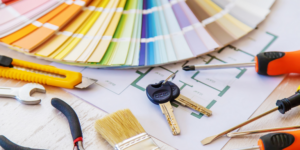Owning and maintaining a home can be a lot of work. Even if your home is newly-constructed, there’s always room for some kind of improvement – perhaps you’d like to improve the energy efficiency of your appliances, redo some lighting fixtures, or add a deck. With spring on the horizon, you might be thinking of ways to refresh your living space or tackle some items on your home improvement to-do list.
Unfortunately, inflation and the rising cost of living may be roadblocks to your home improvement goals, and it can be tricky to determine whether you should make improvements now or wait until prices level off. Let’s take a look at what’s causing price hikes across the board, the benefits of tackling certain projects now vs. delaying improvements, and most importantly, options to pay for it all.
Why are home improvement costs increasing in 2023?
The COVID-19 pandemic sparked an increase in home improvement projects, including many of the DIY variety. With more people stuck inside their homes for longer periods of time (and some adapting to remote work arrangements), many people found it necessary to make changes to their living space. Historically low interest rates during the pandemic also allowed homeowners to fund their DIY projects more easily, although higher lumber costs and other material shortages made it difficult to complete these projects. According to research from Harvard’s Joint Center for Housing Studies, home improvement spending in 2020 increased to nearly $420 billion.
Today, lumber prices remain sky-high, adding an average of $14,000 to the overall cost of building a single-family home, according to the National Association of Home Builders. Paired with rising interest rates that are predicted to continue increasing, home improvement projects are becoming more expensive and less accessible to the average homeowner.
How to pay for home repairs
Ideally, we’d all have an emergency fund to handle home repairs, but the rising cost of living can make this difficult for many people (and some issues simply cannot wait). Luckily, if you need funds for an emergency repair, you have options. Here are a few ways you can finance a home repair.
Personal Loans
If you need funds quickly, a personal loan can be a great option to tackle your next project. Personal loans are typically unsecured, meaning they require no collateral. They allow you to borrow a lump sum of money, and you’ll pay a fixed amount each month until the loan is repaid in full. Best of all, personal loans can be used for nearly any purpose, and the funds are typically sent directly to your bank account with a fast electronic transfer.
If you have good-to-excellent credit, you’re more likely to qualify for a low interest rate on a home improvement personal loan. Rates are typically fixed and are often lower than credit card APRs. If you’d like to shop around for the lowest interest rate, consider using Purefy’s rate comparison tool. Rather than checking rates with each individual lender, you can complete one simple form to compare rates from 15+ lenders in minutes, with no impact on your credit score.
Get Money for Home Improvements in as Little as One Day
Credit Cards
The average credit card APR is in the double digits, so credit cards may not be the best option for most people to pay for home repairs. However, if you have excellent credit and can secure a promotional 0% APR credit card, you could end up saving a significant amount of money if you are able to repay the debt within the promotional time period, which typically lasts anywhere from six to 21 months. But if you can’t repay the debt before the promotional period is over, your APR will return to normal, which could be upwards of 20%. You also will a need high enough credit limit to cover your project, which not all cards may offer.
401(k) loan
If you’ve been saving for retirement through a 401(k) plan with your employer, you may be eligible to borrow against the funds you’ve saved. Interest rates are typically very low, and any interest you pay toward the loan goes back into your 401(k) account. This can be a great option if you are eligible, and you won’t need to undergo a credit check to qualify. The loan payments are automatically deducted from your paycheck, much like the 401(k) contributions themselves, so there’s minimal impact on your day-to-day finances.
However, there is some risk involved – for example, if you cannot repay the loan, the IRS will treat it as an early withdrawal and you’ll have to pay tax penalties. And if you lose your job or switch employers, you’ll need to repay the loan in full. You also may miss out on any potential gains the money would make in your retirement account.
Home Equity Loan/Home Equity Line of Credit (HELOC)
If you’ve owned your home for a while and you’ve built enough equity, you can take out a loan or line of credit against that equity. If you borrow as a home equity loan, you would receive a lump sum and repay the funds with a fixed monthly payment, while a line of credit can be continuously accessed (up to a certain amount) and typically comes with a variable rate. In both situations, the lender would determine how much you can borrow based on the amount of equity you have in your home, and you’ll have to undergo a credit check to be approved.
This type of financing can be risky since your home also functions as collateral for the loan. If you cannot afford the payments, you risk foreclosure. You’ll need a home appraisal to secure the loans, and they often come with high fees and closing costs.
How to choose which home improvement projects to do now
Determining your needs vs. wants is a good starting point in prioritizing your home improvement projects. When budget is a major factor in what you can accomplish, the first step is to handle any repairs that could become costlier down the road if they aren’t addressed. Here are the major areas to consider.
Roof Repairs
When your roof gets to the point of leaking, the damage needs to be addressed as soon as possible. While a home inspection can reveal areas of weakness or damage, in a lot of cases it’s not possible to tell the full extent of the damage (for example, how much rotting wood may need to be replaced) until the existing shingles are stripped. By addressing any leaks as soon as you become aware of them, you can save yourself the hassle of a full roof replacement, which can cost upwards of $10,000.
Regular inspection of your roof can also help you identify issues before they become major problems. Watch out for loose, missing, curled, or cracked shingles, along with any sagging areas in the roof. Dark streaks or other areas of discoloration on shingles can indicate damage, and moss on the roof’s surface can lead to decay. The age of your roof can also shed light on whether or not you’ll need a replacement while you live in the home. On average, asphalt shingles last about 20 years, but environmental factors will also contribute to how long the materials will end up lasting.
Heating and Air Conditioning Repairs
Regular servicing and maintenance of your furnace and air conditioning units can save you from the headache of replacements down the road. Experts recommend servicing each unit once a year to extend the life of your systems and reduce the likelihood of expensive breakdowns. Keeping these systems maintained can also ensure they are running at peak efficiency, which can help you save money on energy bills.
If your systems are nearing the end of their lifespan, it may be worth exploring a more energy-efficient replacement when the time comes. HomeAdvisor has thorough breakdowns of the costs associated with each type of furnace and air conditioning system replacement. There are also federal tax incentives available when you replace your system with a more energy-efficient model, and your state may offer tax breaks as well.
Leaking Pipes and Plumbing Issues
Water damage can cause major issues to your home, so it’s important to repair or replace leaking pipes as soon as possible. However, you may not know about a leaking pipe until significant damage is done. To monitor your home for leaking pipes, you’ll want to keep an eye out for any obvious damage to your ceilings, walls, and floors, including bubbling or peeling paint and discoloration. Musty smells, odd plumbing sounds, and low water pressure can also indicate leaks, and increased usage on your water bill can be another hint that something’s amiss.
To keep your plumbing in good shape, a professional inspection is recommended every two years. Checking for leaks regularly and being conscious of what you put down the drain can help prolong the life of your home’s plumbing.
Electrical Issues
Older homes are more likely to have electrical issues from outdated wiring systems, and if your home needs a partial or full rewiring, you could spend thousands of dollars. Prolonging electrical repairs can be a serious fire hazard, and some issues could put you at risk of electric shock. If your electricity flickers or if your breakers blow frequently, this can be an indication of an underlying problem. Warm outlets or light switches, burning odors, buzzing sounds, and sparking are also red flags.
If you experience any of these issues, it’s a good idea to get a home electrical system inspection. A licensed electrician can identify and correct any faulty wiring, exposed wires, or other fire hazards. Some upgrades are relatively inexpensive, like replacing an old outlet with a GFCI (ground fault circuit interrupter) outlet or grounding an outlet. Upgrading the electrical service or rewiring part or all of your home can cost significantly more.
Foundation Repair
Cracks in your home’s foundation can lead to substantial structural issues without repair. And like most major issues, the longer you wait to repair the foundation, the more expensive the repair will be.
There are a few signs to watch out for that indicate you may have a foundation issue. Large cracks on interior or exterior walls, doors that stick when you open and close them, and bouncy or uneven floors can all indicate foundation damage. Mold and moisture in your crawlspace or basement can also be a sign of leaks in your foundation. If your home has any of these issues, it’s best to bring in a professional as soon as possible. The cost of repairs will vary based on foundation type and severity of the damage – according to HomeAdvisor, the average cost of foundation repair is $4,938.
Termite and Wood Boring Insect Damage
Treating your house for termites and other wood boring insects is a relatively inexpensive preventative that can help you avoid financially devastating repairs down the line. The typical cost of termite treatment ranges from $229 to $961, while repairing termite damage costs an average of $3,000. A Wood Destroying Insect (WDI) inspection can reveal any current or former infestations, and the inspector will also provide an estimate of the cost to treat any issues.
Home Improvement Loan Calculator
See how much your home improvement loan will cost in seconds. Enter your loan amount, interest rate, and repayment term to view your estimated monthly payment and total interest.
Results
$127
Monthly Payment
$3,210
Lifetime Interest
Want to find a low interest home improvement loan? Use our rate comparison tool to check multiple lenders in 2 minutes with no impact on credit.
When can home improvement projects wait?
If your home improvement projects are strictly cosmetic or you’re planning a non-essential renovation, it may be best to hold off until prices go down. While it’s hard to predict where the market is heading, it’s likely that construction costs will remain high in 2023 due to inflation and rising interest rates. On the other hand, some minor updates like painting or replacing fixtures can be done yourself at a relatively low cost. If you don’t have to incur any debt for the project and you feel comfortable handling it yourself, it’s likely worth doing.
Some home improvements can also be done over time as deals arise. For example, if you are planning on replacing some or all of your furniture, consider combing thrift stores, estate sales, and secondhand marketplaces like those found on Nextdoor or Facebook rather than financing brand-new furnishings. While this process can be a mixed bag depending on your location, there are often great deals to be found — it just takes a bit of patience.
If you do find that you need to purchase new furniture, consider waiting for a major holiday sale so you can score the best deal. Around President’s Day, Memorial Day, Labor Day, and Black Friday, furniture retailers typically offer significant sales or markdowns, and some larger companies will also offer 0% APR promotional financing. Like many industries, COVID-related supply chain bottlenecks have also plagued the furniture industry, so you may experience longer lead times to receive your purchases, which is also an important consideration.
The bottom line
While the timing may not be ideal to do home improvements in 2023 as prices remain high, some things can’t wait. If your home needs any major fixes that could become more costly in the long run, it’s best to keep up with those repairs. And if you do need to seek financing, be sure to research and compare your options before deciding on the best fit. If you choose a personal loan, use our rate comparison tool to shop multiple lenders with one form to find the best deal for your financial situation.













